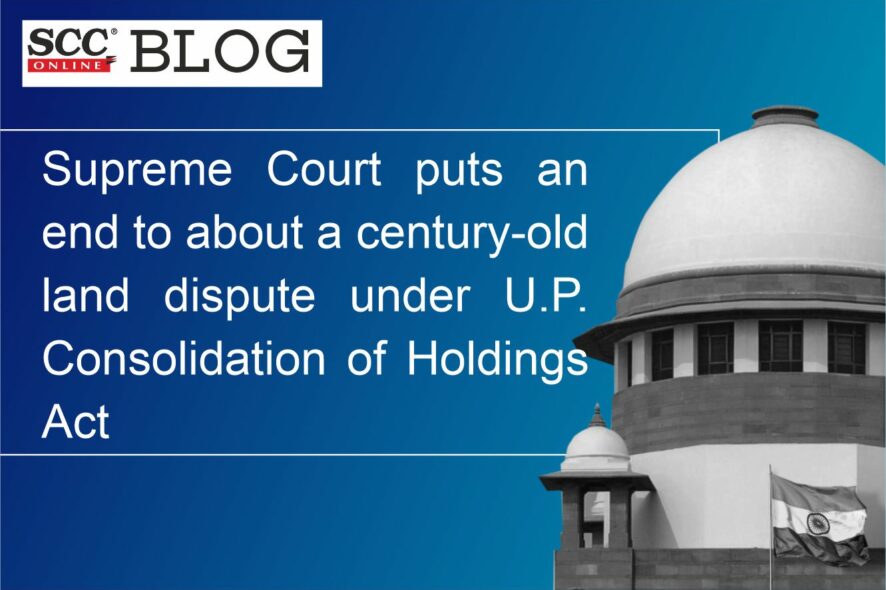Supreme Court: While deciding about a century-old land dispute, the Division Bench of Hemant Gupta and V. Ramasubramanian*, JJ., upheld the impugned decision of the Allahabad High Court.
The Court held that since all the three brothers were alive when the Civil Court passed the partition decree, the Consolidation authorities were well within their powers—considering the subsequent death of two brothers—to hold that the shares of the brother who died issueless should be equally distributed among heirs of his two brothers.
Litigation History
The instant appeal was filed to assail the outcome of the proceedings under Section 9A (2) of the U.P. Consolidation of Holdings Act, 1953.
The common ancestor of both the parties was one Gajadhar Misra, who had three sons namely Sita Ram, Ramesar, and Jagesar. Sita Ram died issueless. Ramesar had a son named Bhagauti.
In the year 1928, Bhagauti filed a suit for partition before the Additional Civil Court. However, by consent of the parties, the dispute was referred to arbitration and the suit was decreed in terms of the arbitration award. In 1944, the said decree was challenged by Bhagauti claiming that the decree was collusive and not binding, which was dismissed by the Trial Court and dismissal was further confirmed by the Appellate Court.
Evidently, the mutation in the revenue records took place in 1952, and thereafter objections were filed by both parties under Section 9 of the U.P Consolidation of Holdings Act, 1953. The rival contentions revolved around the validity of the partition decree and dismissal of the subsequent suit of 1944.
The Consolidation officer passed an Order dated 04-05-1973, holding that the share of Ramesar got separated in the partition that took place in 1929 and that the shares of Jagesar and Sita Ram were held jointly and therefore, upon the death of Sita Ram without any issues, his share would have gone to Jagesar. Consequently, the consolidation Officer held that heirs of Ramesar will get only 1/3rd share and that of Jagesar will get 2/3rd share.
The order of the Consolidation Officer was assailed before the Assistant Settlement Officer who dismissed the matter. In revision, the Deputy Director of Consolidation held that the preliminary decree for partition granted in the suit of the year 1929 was never given effect. Noting that there was no evidence to show who among the two namely, Sita Ram and Ramesar died first, the revisional Authority held that both the branches of Ramesar and Jagesar were entitled to half share each.
The decision of the Revisional Authority was upheld by the Allahabad High Court in appeal.
Issue in Question
The appellants contended that the authorities under the Consolidation of Holdings Act cannot go beyond the decree passed by the Civil Court and that a preliminary decree for partition attains finality as regards the shares to which the parties are held entitled, even if no final decree has been passed resulting in the actual division by metes and bounds.
The appellants contended that since the contention that the preliminary decree of 1929 was collusive already stood rejected in 1944, the authorities under the Consolidation Act were obliged to give effect to the preliminary decree for partition.
Factual Analysis
The Court noted that at the time when the suit for partition of the year 1929 was decreed based on an arbitration award, all the three brothers namely Sita Ram, Ramesar, and Jagesar were alive and they all were held entitled to 1/3rd share each. It was only subsequently that Sita Ram died issueless. Further, none of the parties have any clue as to the exact date of death of Sita Ram or Ramesar to determine who predeceased whom.
Rejecting the claim of the branch of Jagesar that Ramesar predeceased Sita Ram, therefore, Sita Ram’s 1/3rd shares came to Jagesar by survivorship, the Court observed that there were no categorical findings with regard to who predeceased whom even in the judgment passed in Suit 1944. The Court stated,
“To put it in simple terms, Jagesar’s branch would be entitled to take Sita Ram’s 1/3rd share only if it is established that Ramesar had predeceased Sita Ram.”
Hence, the Court held that the revisional authority under the Consolidation Act had not gone beyond the Civil Court’s decree for partition since at the time of partition all the three brothers were alive.
The authorities under the Consolidation Act were confronted with two questions, namely,
(i) whether Sita Ram or Ramesar died first; and
(ii) whether Sita Ram’s 1/3rd share would go to Jagesar by way of survivorship if he had died after Ramesar.
The Court noted that the answer to the aforementioned questions did not depend upon the partition decree. Therefore, the only ground of attack to the order of the Deputy Director of Consolidation cannot be sustained. The Court opined that though the Deputy Director of Consolidation did not articulate his discussion on the issue with clarity, the same will not make his order vulnerable.
Conclusion
Hence, the Court concluded that the Consolidation authorities did not go beyond the Civil Court’s decree. Upholding the impugned decision of the High Court, the Court held that since there was no evidence regarding the dates of death, the Deputy Director of Consolidation rightly found it equitable to distribute Sita Ram’s 1/3rd share equally between the branches of Ramesar and Jagesar.
The instant appeal was dismissed.
[Sarju Mishra v. Jangi, 2022 SCC OnLine SC 873, decided on 13-07-2022]
*Judgement by: Justice V. Ramasubramanian
Advocates who appeared in this case :
Senior Advocate S. R. Singh counsel, Advocate, for the Appellants;
*Kamini Sharma, Editorial Assistant has reported this brief







